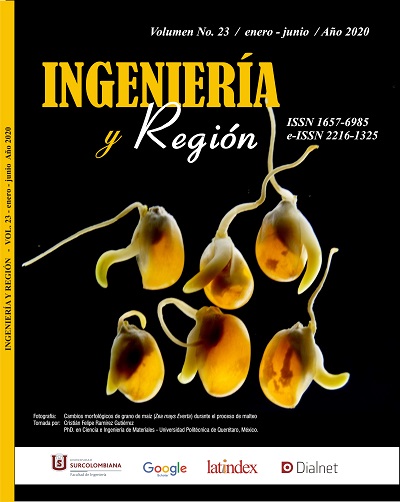Proposal for sustainability of the water ecosystem service in productive systems of the associative group ASOENSAY
##plugins.themes.bootstrap3.article.main##
In rural areas, the supply of water comes from ecosystem services that allow the distribution of this resource in agricultural, livestock and household activities. This generates alterations in the water’s quality and long-term availability. Some studies suggest this deterioration comes mainly from the productive chain of the agricultural sector. This scenario led to the structuring of a model that contributed to the sustainability of the water ecosystem service. To do so, the sources supplying the farms of the associative group ASOENSAY in San Isidro village were characterized through a physical-chemical and microbiological sampling. Additionally, a structured survey was conducted, which allowed the collection of information concerning water uses and practices that producers considered viable to implement according to their socio-economic and productive dynamics.
The results established that the water is good in terms of quality indices, whereas the qualifications ranged from low to very low at the level of pollution. As a result, the availability of the water ecosystem service and the benefit that producers obtain by taking advantage of quality and quantity to supply activities of the rural environment should correspond to a water sustainability proposal that evidenced the uses of water as a variable that conditioned the supply of the resource. Therefore, a set of management measures were determined allowing the balance of the supply-demand relationship in the established model. It was concluded that the water accessed has favorable characteristics that make it possible to boost productive activities. This is why producers must facilitate the implementation of preventive, mitigation and compensation practices that guarantee the availability of the water ecosystem service for future generations.
Downloads
##plugins.themes.bootstrap3.article.details##
Agencia para el Desarrollo Internacional-USAID-. 2016. Análisis sectorial del agua. Programa pilotos de innovación financiera.https://www.asobancaria.com/wp-content/uploads/2016/10/diagnostico-sectorial-agua-pilotos-de-innovacion-financiera.pdf. Consultado 28 de marzo de 2019.
Aguilar, I y Monforte, G. (2018). Servicios públicos del agua, valor público y sostenibilidad. El caso del área metropolitana de Monterrey. Gestión y política pública. 1, 149-179.
Alcaldía de Campoalegre-Huila. (2016). Plan Básico de Ordenamiento Territorial. Campoalegre-Huila.http://www.campoalegre-huila.gov.co/Transparencia/Plan%20basico%20Ordenamiento/PBOT/04%20FORMULACION%20PBOT%20CAMPOALEGRE%202016.pdf. Consultado 21 de enero de 2019.
Álvarez, X. (2015). Modelo conceptual de la eutrofización y proliferación de cianobacterias. Un caso de estudio en el embalse de A Baxe. (tesis doctoral). Universidad de Vigo, España.
Andrade, H., Segura, M y Sierra, E. (2017). Percepción local de los servicios ecosistémicosofertados en fincas agropecuarias de la zona seca del Norte del Tolima, Colombia. DOI: 10.17151/luaz.2017.45.4
Bellaubí, F. 2016. Sostenibilidad, territorio y agua. Acta nova. 7(4), 510-518.Caho, C y López, E. (2017). Determinación del índice de calidad de agua para el sector occidental del humedal Torca-Guaymaral empleando las metodologías UWQI y CWQI. https://doi.org/10.22507/pml.v12n2a3
Centro de estudios avanzados en niñez y juventud. 2016. La crisis del agua: Un problema tan grave como el del cambio climático. Revista latinoamericana de ciencias sociales, niñez y juventud. 14(1), 711-712.
Corporación Autónoma Regional del Valle del Cauca –CVC-. (2017). Evaluación regional del agua Valle del Cauca-2017. https://www.cvc.gov.co/sites/default/files/2018-10/EVALUACION_REGIONAL_AGUA_Ajustes2018_2.pdf. Consultado 20 de septiembre de 2018.
IDEAM (Instituto de Hidrología, Meteorología y Estudios Ambientales), INVEMAR (Instituto de Investigaciones Marinas y Costeras José Benito Vives de Andreis), SINCHI (Instituto Amazónico de Investigaciones Científicas), IIAP (Instituto de Investigaciones Ambientales del Pacífico John Von Neumann) y IAvH (Instituto de Investigación de Recursos Biológicos Alexander von Humboldt). (2016). Informe del estado del medio ambiente y de los recursos naturales 2015. Documento síntesis.http://documentacion.ideam.gov.co/openbiblio/bvirtual/023641/IEARN2015.pdf.Consultado 23 de mayo de 2018.
International Center for Tropical Agriculture y Research Program on Water, Land and Ecosystems. (2015). Estado de avance y cuellos de botella de los mecanismos de retribución por servicios ecosistémicos hidrológicos en Perú. http://www.bosquesandinos.org/wp-content/uploads/2016/01/cuellos_botella_2015_digital.pdf. Consultado 05 de febrero de 2018. Revista Ingeniería y Región Vol. 23 DOI 10.25054/22161325.2246Enero/Junio 2020-Universidad Surcolombiana
Landis, D. (2017). Designing agricultural landscapes for biodiversity-based ecosystem services. https://doi.org/10.1016/j.baae.2016.07.005
Larrain, F y Sachs, J. (2002). Macroeconomía en la economía global. Buenos Aires, Argentina: Pearson Education S.A.
López, A., Martínez, L., Feria, J y Cruz, J. 2016. Planificación del recurso hídrico en la quebrada Aguas Blancas, zona rural de Montería, Córdoba.https://doi.org/10.15665/rp.v14i2.567
Martínez, P.y Flores, P. (2015). Diseño de sistemas y políticas públicas de pagos por servicios de los ecosistemas. http://www.comunidadism.es/wp-content/uploads/downloads/2015/02/pago-por-servicios-ambientales.pdf. Consultado 30 de octubre de 2019.
Ministerio de Ambiente y Desarrollo Sostenible. (2018). Guía de aplicación de la valoración económica ambiental. http://www.minambiente.gov.co/images/NegociosVerdesysostenible/pdf/valoracion_economica_ambiental/Gu%C3%ADa_de_aplicaci%C3%B3n_de_la_VEA_Comprimida.pdf. Consultado 12 de marzo de 2018.
Modigliani, F. (1988). Life Cycle, Individual Thrift, and the Wealth of Nations (Nobel Lecture). En Macroeconomics and Finance: Essays in Honor of Franco Modigliani, editadopor R. Dornbusch, S. Fischer y J. Bossons. Cambridge, Mass., EE.UU.: MIT Press.
Organización de las Naciones Unidas para la Educación, la Ciencia y la Cultura-UNESCO-.(2019). Informe mundial de las naciones unidas sobre el desarrollo de los recursos hídricos 2019. No dejar a nadie atrás. https://www.acnur.org/5c93e4c34.pdf. Consultado 06 de noviembre de 2019.
Ortiz, R., González, J y Chávez, J. 2015. Modelo de asignación de agua considerando un caudal ambiental mínimo en la cuenca del Río Metztitlan en Hidalgo, México. Agrociencia. 49(7), 703.721.
Ramos, I., Holgado, D., Maya, I y Palacio, J. (2014). Evaluación de procesos comunitarios y análisis de redes interorganizativas: elementos para mejorar la efectividad de las intervenciones comunitarias. https://doi.org/10.16925/pe.v10i17.798
Rodríguez, J., Serna, J y Sánchez, J. (2016). Índices de calidad en cuerpos de agua superficiales en la planificación de los recursos hídricos. http://dx.doi.org/10.22335/rlct.v8i1.306
Rossetto, R., Filippis, G., Triana, F., Ghetta, M., Borsi, I y Schmid, W. (2019). Software tools for management of conjunctive use of Surface-and ground-wáter in the rural environment: integration of the farm process and the Crop Growth Module in the FREEWAT platform. https://doi.org/10.1016/j.agwat.2019.105717
Zeinalzadeh, K y Rezaei, E. (2017). Determining spatial and temporal changes of Surface wáter quality using principal component análisis. https://doi.org/10.1016/j.ejrh.2017.07.002


















